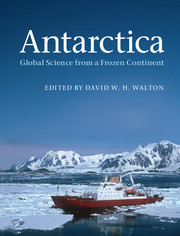Book contents
- Frontmatter
- Contents
- List of contributors
- Introduction
- 1 Discovering the unknown continent
- 2 A keystone in a changing world
- 3 Ice with everything
- 4 Climate of extremes
- 5 Stormy and icy seas
- 6 Life in a cold environment
- 7 Space science research from Antarctica
- 8 Living and working in the cold
- 9 Scientists together in the cold
- 10 Managing the frozen commons
- 11 Antarctica: a global change perspective
- Appendix A Visiting Antarctica
- Appendix B Further reading
- Acknowledgements
- Index
5 - Stormy and icy seas
Published online by Cambridge University Press: 05 March 2013
- Frontmatter
- Contents
- List of contributors
- Introduction
- 1 Discovering the unknown continent
- 2 A keystone in a changing world
- 3 Ice with everything
- 4 Climate of extremes
- 5 Stormy and icy seas
- 6 Life in a cold environment
- 7 Space science research from Antarctica
- 8 Living and working in the cold
- 9 Scientists together in the cold
- 10 Managing the frozen commons
- 11 Antarctica: a global change perspective
- Appendix A Visiting Antarctica
- Appendix B Further reading
- Acknowledgements
- Index
Summary
As we laboured south the storm continued with increasing violence, for now we were entering the ‘Roaring Forties’. Our vessel staggered to the crest of mountainous seas and plunged heavily down long troughs.
Frank Hurley, 1925The geographical setting
The cold and stormy Southern Ocean surrounds the Antarctic continent and connects the southernmost parts of three major ocean basins – the Atlantic, the Indian and the Pacific Ocean. This stretch of water, although far from most centres of population, has a crucial effect on the global climate system through its role in the circulation of the world's oceans, the uptake of carbon dioxide from the atmosphere and, through its formation of annual sea ice, an influence on climate elements of importance to marine productivity.
Formally, its northern limit is now taken as 60°S, corresponding roughly to the southern boundary of the Antarctic Circumpolar Current and to the northern limit of sea ice in winter. Covering an area of 20.3 million km2, its mean depth is 4500 m (with its greatest depth being 7235 m). However, to appreciate its role in the climate system, the complete Antarctic Circumpolar Current has to be included reaching as far north as 40°S. Then, the Southern Ocean covers 70 million km2 which corresponds to 20% of the world's oceans. Where the Drake Passage separates Cape Horn on the South American side from the South Shetland Islands on the Antarctic side it is only 800 km wide, whereas the distance from South Africa (Cape Agulhas) to the Antarctic continent (Dronning Maud Land coast) is 3900 km. To the south the Southern Ocean is limited by the Antarctic coastline of 17 968 km which is largely covered by ice shelves.
- Type
- Chapter
- Information
- AntarcticaGlobal Science from a Frozen Continent, pp. 137 - 160Publisher: Cambridge University PressPrint publication year: 2013

